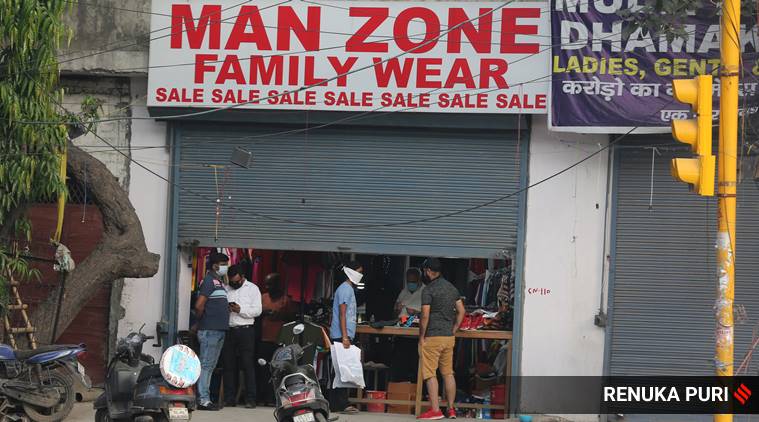 A shop in Ramesh Nagar, Delhi, on Saturday.
A shop in Ramesh Nagar, Delhi, on Saturday.
Despite its initial reservations, the Delhi government on Saturday evening decided to allow standalone shops as well as those in neighbourhoods and residential complexes, selling both essential and non-essential items, to open. The announcement is in line with the Union Home Ministry’s advisory late Friday night, relaxing curbs to allow functioning of select shops.
The state government’s decision will not cover liquor or barber shops, and will not be applicable to the 95 containment zones in the Capital. Confusion had prevailed through the day, with some shops opening, but market associations asking members not to rush in.
Other states reacted differently to the Centre’s guidelines, with Gujarat, Kerala and Odisha saying shops can open, while Punjab, Maharashtra, West Bengal and Uttar Pradesh said they would maintain status quo. Like in Delhi, confusion prevailed in Rajasthan, Haryana and Madhya Pradesh, where traders downing shutters after opening them in the morning. By evening, Haryana clarified that shops will open from Sunday, Madhya Pradesh said shops would open except in hotspots and containment areas, and Rajasthan issued a clarification in line with the Union Home Ministry’s clarification on Saturday afternoon – that in rural areas, all shops except shopping malls are allowed to stay open, whereas in urban areas, all standalone shops, neighbourhood shops and residential complexes are allowed to open.
Maharashtra, which continues to report the highest number of COVID-19 deaths in the country at 323, refused to ease lockdown at least until May 3. In Mumbai and Pune, the lockdown is likely to be extended to May 15.
According to sources in Delhi, senior officials and experts had told the government that lifting relaxations in Delhi was not feasible, considering the sudden uptick in the number of cases over the past few days. Delhi saw 111 fresh cases on Saturday. The government had agreed with the decision, an official said on condition of anonymity.
Coronavirus outbreak: 33 healthcare workers test positive at Max hospital in New Delhi
During the first half of the day, top officials in the government also maintained that relaxations, “if any”, will be allowed only after April 27, and till then, “complete” lockdown will be observed.
“But on Saturday afternoon, as TV channels reported that MHA had relaxed the rules, shops started opening despite there being no go-ahead from the state government. When our officials went to these areas and asked people to shut their shops and follow the Delhi government guidelines, they showed them the MHA order and said the Centre was the final authority. In many areas, things got heated and a law and order situation emerged. In 3-4 places, officials were pushed around by shop owners. We realised that things had got out of control and had to convene a meeting, where it was decided late in the evening that there was no option but to take the MHA line,” said an official who did not want to be named.
Delhi government officials, however, maintained that the previous relaxations proposed by the MHA in terms of allowing electricians, plumbers and carpenters will not be implemented in Delhi for now.
Having “reluctantly” agreed to the Home Ministry directive, the Delhi government has simultaneously decided to scale up a model — already implemented in parts of old Delhi — to break up every major containment zone into multiple sectors to prevent violations inside sealed areas.
“How can one allow relaxations when sealed zones are rising every day? But what can we do now that the Centre has taken a unilateral decision? The primary focus will continue to be on the rising number of cases, even at the sealed zones. So a decision has been taken by Lt Governor Anil Baijal, Chief Secretary Vijay Dev and other officials to break the containment zones into multiple clusters for more effective implementation of the restrictions, which are now being violated in many places as neighbours are intermingling,” a senior official said.
The official explained that in many cases, the distance between two checkpoints in containment zones is too large, which does not allow police and other officials to regulate movement of people. “Now more checkpoints will be put in place between the existing ones. For each such cluster, there will be separate teams of doctors and other officials for preventing transmission,” the official added.
While the total population in the sealed zones stands at around 3.57 lakh, officials hope that the enforcement of the restrictions in areas such as Chandni Mahal, Jahangirpuri and Sadar Bazar will be easier once the demarcation exercise is completed.
“After May 3, there will be some relaxations in terms of de-sealing of some containment zones. There are around 30 spots where no new cases have been reported in the last two weeks. Also, the other relaxations outlined by the MHA are likely to be implemented. Much also depends on the graded approach of the Centre. Also, once you allow standalone shops, selling coolers, ACs, etc to operate, electricians, plumbers will be considered exempted as a natural corollary,” another official privy to the discussions said.
They also pointed out how the template of opening up districts that are not registering many cases — being mulled across states — cannot be directly implemented in the city, where there are 11 districts, all of which have containment zones. “In this city, a person hardly realises when they move from one district into another,” the official said.
With ENS inputs